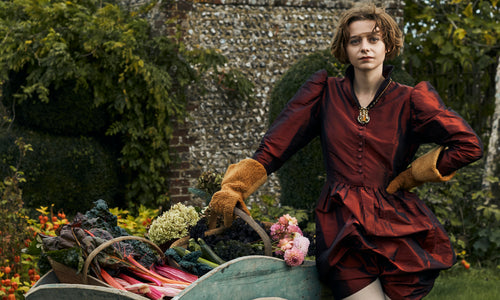CHIT-CHAT-EAU Episode No. 6: Holly James Johnston, Writer, Presenter and Performer

Our sixth guest is Holly James Johnston. By day, Holly is busy completing a PhD at the University of Oxford, studying queer coming-of-age stories in the early twentieth century, with a focus on Vita Sackville-West, Christopher St. John, Radclyffe Hall and Virginia Woolf. By night, Holly transforms into her alter ego, and performs as the drag king Orlando, taking inspiration from 19th and 20th century literature and history.
Luke recently came across Holly and Orlando via Instagram (of course), and was instantly captivated. After all, anyone with a passion for Virginia Woolf and Saint Sebastian (plus a penchant for shoulder pads and the dressing up box) gets Luke’s immediate attention.
Learn about the beginnings of Orlando, Holly’s art history museum projects, and the podcast she made recently with the author Diarmuid Hester below...

Can you tell us about your alter ego, Orlando? How did this drag performance come about?
Orlando was born on The Royal Vauxhall Tavern stage in London, January 2017. I’d wanted to do drag for a while, but I held a lot of preconceptions about what drag is, or isn’t. After all, mainstream perceptions still widely understand drag as men dressing up as women. I suppose I felt a certain amount of imposter syndrome, as if it wouldn’t count as drag if I did it. Drag kings weren’t as prevalent as they are now. When I watched Sally Potter’s film adaptation of Virginia Woolf’s Orlando (1928), however, I was inspired by Tilda Swinton’s playful and carefree performance as Orlando. Male or female, she plays Orlando as if there’s nothing to prove. The film helped me reframe my ideas about drag. Once I realised drag is merely a performance of gender, and not necessarily even a performance of the ‘opposite gender’, it became an arena to experiment with gender in all its multitudes. From these earnest and quite academic beginnings, Orlando has since developed a life of his own. He’s a lot of fun – an unruly dandy with foppish hair and a painted face, who expects me to manage his diary, steam his clothes, the list goes on… When he isn’t performing, he enjoys life as a lady of leisure.
Why Orlando? What is it about Virginia Woolf’s character that so appeals?
It had to be Orlando. Woolf’s Orlando is a glittering romp from manhood to womanhood, where masculinities and femininities are lost and found. It’s an enduringly sublime and potent incantation of gender. When I began doing drag, I had no idea where Orlando would go – whether he’d want to be a drag king, queen, or something in-between. Woolf brings an expansive approach to selfhood in Orlando. When the spirit of Orlando is applied to drag, you realise it’s all for the taking. For me, the name Orlando held so many possibilities.
What projects are you working on at the moment?
I’m currently developing a course on queer art history for the V&A Academy, which will run next year. I’m also working on a new short film with The National Gallery. My main project is my PhD, which I’m completing at the University of Oxford. I’m studying queer coming-of-age stories in the early twentieth century, focusing on Vita Sackville-West, Christopher St. John, Radclyffe Hall, and Virginia Woolf. The coming-of-age story is an enduring genre in popular media – look at the success of Alice Oseman’s Heartstopper, for instance. I’m interested in why queer writers turned to the coming-of-age story a hundred years ago. My research explores how the genre became a repository for all sorts of questions about what it meant to be queer.
If you could go back in time and live in one particular historical period, which would it be?
I’m not sure one could live in the dinosaur age – visit perhaps, but it would be cinematic to see dinosaurs roaming the Earth, providing you didn’t get squashed. I’d like to live in Edwardian England, probably because I’d quite like to live in a Merchant Ivory film.
A favourite historical crush?
Vita Sackville-West. That writing tower of hers at Sissinghurst… I don’t know what I fancy more, Vita or the writing tower.

Talk to us about the podcast you made recently with the author Diarmuid Hester.
Diarmuid and I recently made a queer history podcast series in the style of a road trip, titled Into That World Inverted. While the title borrows from an Elizabeth Bishop poem, it is also a nod towards late nineteenth and twentieth century understandings of queerness as a form of ‘sexual inversion’. The premise is two friends set off on a road trip of the South East of England to unearth and explore its queer histories. Beginning in Margate, we journey to Sissinghurst, Smallhythe Place, Rye, Prospect Cottage, and finish in St. Leonards, making friends along the way. Diarmuid is a brilliant thinker and writer, so it was a real treat to spend a week together visiting places that have meant so much to queer people, past and present.
Your favourite novel, flower, song, colour?
E. M. Forster’s Maurice (1971) (my heart!); violets; Blue Monday by New Order; green.
Name a country you haven't been to that you'd like to visit, and tell us why.
I won’t be the first person to want to visit Japan after watching a Studio Ghibli film. I suppose it’s because the culture is so different to here in the UK. I’ve always wanted to catch the cherry blossom season.
Your last supper on the planet?
A meal cooked by my mother.